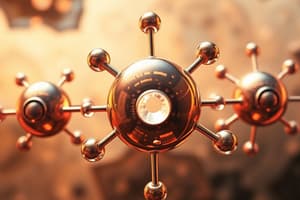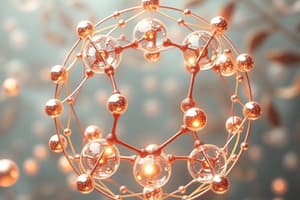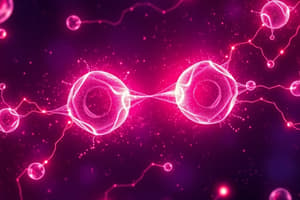Podcast
Questions and Answers
Which type of bond involves the sharing of electrons between non-metals?
Which type of bond involves the sharing of electrons between non-metals?
- Metallic bond
- Ionic bond
- Covalent bond (correct)
- Polar bond
What indicates a covalent compound when naming?
What indicates a covalent compound when naming?
- They end with 'ate'
- The ending changes to 'ide' (correct)
- They use Roman numerals
- Prefixes indicate the number of molecules (correct)
Which of the following is NOT a diatomic element?
Which of the following is NOT a diatomic element?
- Oxygen
- Carbon (correct)
- Hydrogen
- Chlorine
What is a characteristic of ionic bonds?
What is a characteristic of ionic bonds?
What kind of intermolecular forces do giant covalent compounds have?
What kind of intermolecular forces do giant covalent compounds have?
How do metallic structures differ from covalent compounds in terms of electron behavior?
How do metallic structures differ from covalent compounds in terms of electron behavior?
What describes a polar covalent bond?
What describes a polar covalent bond?
Which statement about electrolytes is true?
Which statement about electrolytes is true?
What type of bond is formed through the sharing of electrons between atoms?
What type of bond is formed through the sharing of electrons between atoms?
What is the charge of a calcium ion when it forms an ionic bond?
What is the charge of a calcium ion when it forms an ionic bond?
Which of the following statements accurately describes ionic compounds?
Which of the following statements accurately describes ionic compounds?
How do ionic compounds achieve electrical neutrality?
How do ionic compounds achieve electrical neutrality?
Which of the following compounds is an example of an ionic binary compound?
Which of the following compounds is an example of an ionic binary compound?
What is the formula for Calcium Fluoride?
What is the formula for Calcium Fluoride?
Which of the following is a polyatomic ion?
Which of the following is a polyatomic ion?
Which statement correctly describes the alignment of charges in ionic bonds?
Which statement correctly describes the alignment of charges in ionic bonds?
What characterizes a polar covalent bond compared to a pure covalent bond?
What characterizes a polar covalent bond compared to a pure covalent bond?
Which bond is likely to form between a metal and a non-metal?
Which bond is likely to form between a metal and a non-metal?
What is a characteristic property of ionic compounds?
What is a characteristic property of ionic compounds?
What happens to valence electrons in an ionic bond?
What happens to valence electrons in an ionic bond?
Which of the following statements about non-polar covalent bonds is true?
Which of the following statements about non-polar covalent bonds is true?
Why do ionic compounds have high melting and boiling points?
Why do ionic compounds have high melting and boiling points?
Which type of bond is characterized by an electronegativity difference of less than 0.4?
Which type of bond is characterized by an electronegativity difference of less than 0.4?
What term is used to describe the Greek letter that indicates partial positive and negative charges in a molecule?
What term is used to describe the Greek letter that indicates partial positive and negative charges in a molecule?
Flashcards
Compound
Compound
A substance formed when two or more different elements chemically combine in a fixed ratio.
Chemical Bond
Chemical Bond
A force of attraction that holds atoms together.
Ionic Bond
Ionic Bond
A bond formed by the electrostatic attraction between oppositely charged ions.
Ion
Ion
Signup and view all the flashcards
Ionic Crystal
Ionic Crystal
Signup and view all the flashcards
Covalent Bond
Covalent Bond
Signup and view all the flashcards
Polyatomic Ion
Polyatomic Ion
Signup and view all the flashcards
Zero-Sum Rule
Zero-Sum Rule
Signup and view all the flashcards
Covalent Compound
Covalent Compound
Signup and view all the flashcards
Lewis Dot Diagram
Lewis Dot Diagram
Signup and view all the flashcards
Electronegativity
Electronegativity
Signup and view all the flashcards
Polar Covalent Bond
Polar Covalent Bond
Signup and view all the flashcards
Non-polar Covalent Bond
Non-polar Covalent Bond
Signup and view all the flashcards
Electrolytes
Electrolytes
Signup and view all the flashcards
Molecular Shape
Molecular Shape
Signup and view all the flashcards
Electronegativity difference
Electronegativity difference
Signup and view all the flashcards
Ionic Compound
Ionic Compound
Signup and view all the flashcards
Interparticle Attraction
Interparticle Attraction
Signup and view all the flashcards
Polar Molecule
Polar Molecule
Signup and view all the flashcards
Study Notes
Chemical Bonds
- Elements are typically found in compounds, not by themselves
- A compound is a substance composed of different elements (a mixture)
- Bonds are a persistent attraction between two or more atoms
- Ionic bonds: Electrostatic forces between oppositely charged ions (crystalline)
- Covalent bonds: Sharing of electrons
- Like charges repel, opposite charges attract
Ionic Bonds
- Ions are charged (+ or -)
- Ions attract each other (Coulomb's Law)
- Atoms gain or lose electrons to achieve a full valence shell
- Stable ionic structures form when charges balance
- Ionic crystals: Regular arrangements of atoms held together by attraction between ion pairs
- Properties: hard, brittle, crystalline, high melting point
- Exist as crystals
- Simple ions: Single atoms that have become charged
- Naming ionic compounds: Write the metal first, then the non-metal, and change the non-metal ending to "ide" (e.g., sodium chloride).
Ratios
- Compounds must be electrically neutral overall
- Balancing ratios neutralize the compound
- Example: Calcium fluoride (CaF₂) needs two fluoride ions to balance the positive charge of one calcium ion.
- Ionic compounds are stable only when neutral (zero-sum rule).
Polyatomic Ions
- Polyatomic ions are ions comprised of multiple atoms acting as a single ion
- Atoms are covalently bonded within the ion
- Naming compounds with polyatomic ions: Polyatomic ions are written as a group behind the positive ion
Multivalent Ions
- Some ions have varying charges (multivalent). Their charges are indicated with Roman numerals using parentheses (e.g, iron (II), iron (III)).
- Multivalent atoms are often transition metals.
- Use roman numerals in parenthesis when naming.
Covalent Bonds
- Covalent bonds are formed by nonmetals
- Covalent compounds form molecules
- Molecules make up larger structures
- Sharing electrons enables atoms to achieve a full outer shell
- Lewis dot diagrams: Show the arrangement of valence electrons
- Naming covalent compounds: Written left to right based on position on the periodic table. Prefixes indicate the number of atoms of each type in the molecule.
Diatomic Elements
- Some elements exist in nature as single bonded pairs (diatomic elements)
Video: Chemical Bonds
- Metals usually have 1-3 valence electrons; nonmetals usually have 4-8 valence electrons
- Ionic bonds have high melting points because a lot of energy is needed to break them apart
- Covalent bonds also require energy to break apart
- Covalent compounds come in three forms:
- Simple covalent: weak intermolecular forces, low boiling points.
- Giant covalent: Strong intermolecular forces, high boiling points
- Polymers: Complex long chains connecting similar units.
Other Information
- Electrolytes: Compounds that conduct electricity
- Ionic compounds separate into ions in water, a process called dissociation
- Covalent compounds do not conduct electricity because they aren't charged
- Molecular shape: 3D arrangement of atoms to show molecules
Polarity and Electronegativity
- Polarity: How unevenly electrons are distributed in a covalent bond
- Polar covalent bond: Uneven electron sharing
- Non-polar covalent bond: Even electron sharing
- Electronegativity: Atoms' ability to attract electrons in a bond
- A high electronegativity difference between atoms indicates a polar bond; a low electronegativity difference between atoms indicates a non-polar bond.
Difference in Ionic and Covalent Compounds
- Ionic bonds form crystalline solids; high melting and boiling points, hard, soluble in water. Conducts electricity when dissolved or is a liquid; no odor, definite shape, not crushable, strong interparticle attractions.
- Covalent bonds form gases, solids, and liquids; low melting and boiling points; soft, some soluble in water, some not; poor electrical conductors, often odor-bearing + definite shape, crushable, weak interparticle attractions
Covalent: Polar vs Non-polar
- Polar covalent bonds: The electronegativity difference is greater than 0.4- 0.5, electrons are unequally shared
- Non-polar covalent bonds: The electronegativity difference is smaller than 0.4 -0.5, Electrons are shared equally.
Studying That Suits You
Use AI to generate personalized quizzes and flashcards to suit your learning preferences.




